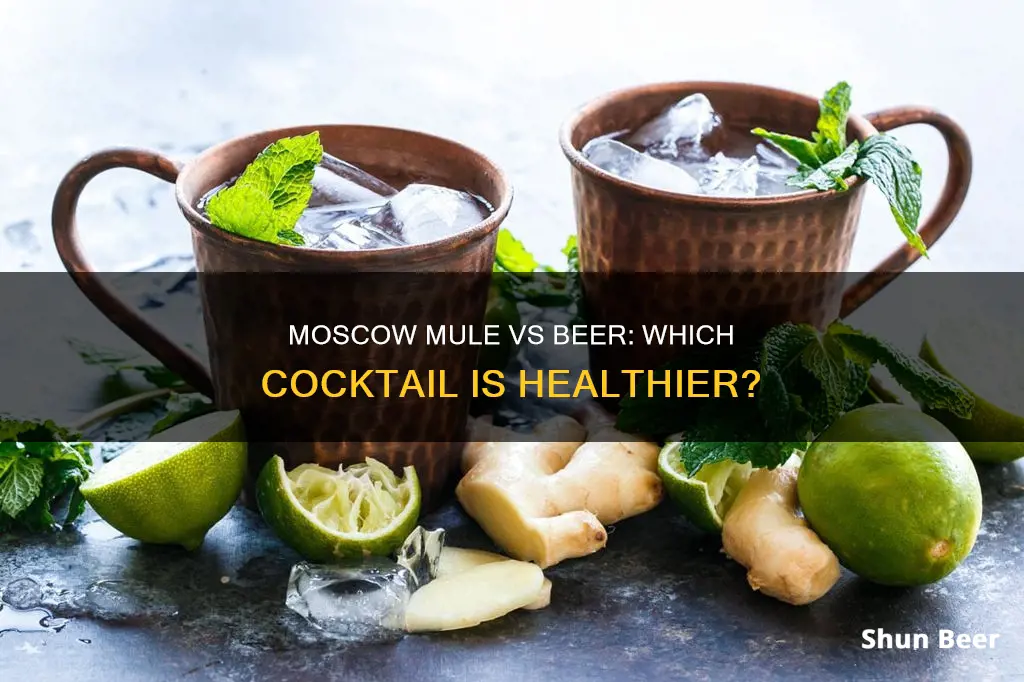
The Moscow Mule is a cocktail made with vodka, ginger beer, and lime juice. It is often garnished with a slice of lime and a sprig of mint. The drink is served in a copper mug, which is said to keep the cocktail cool and refreshing. While the Moscow Mule is associated with Russia, it was actually invented in Los Angeles in the 1940s.
A classic Moscow Mule contains approximately 208 calories. The virgin or non-alcoholic version of the drink is a healthier alternative, omitting the vodka and replacing it with club soda or sparkling water.
So, are Moscow Mules healthier than beer? It depends on various factors, including the ingredients used and the amount consumed. However, a non-alcoholic Moscow Mule is likely to be a healthier choice compared to a beer, as it contains fewer calories and no alcohol.
| Characteristics | Values |
|---|---|
| Calories | One serving of a Moscow Mule contains 208 calories. |
| Alcohol Content | 10.8% alc./vol. (21.6° proof) |
| Pure Alcohol Content | 18.9 grams |
| Carbohydrates | 15g |
| Copper Mugs | Copper mugs are traditionally used to serve Moscow Mules, but some public health advisories recommend using copper mugs with a protective coating (e.g. stainless steel) to reduce the risk of copper toxicity. |
What You'll Learn

Moscow Mule Ingredients
The Moscow Mule is a simple cocktail with a unique blend of ingredients that complement each other to create a refreshing and flavourful drinking experience. Here is a detailed breakdown of the essential components that make up this classic cocktail:
Vodka
The primary spirit in a Moscow Mule is vodka, which provides a neutral base that allows the other ingredients to shine. Any unflavoured vodka will work, and you can choose your preferred brand or simply use whatever is available. The vodka serves as a foundation for the cocktail, enhancing the flavours without overwhelming them.
Ginger Beer
The choice of ginger beer is crucial to the overall taste of the Moscow Mule. Look for a high-quality ginger beer with a strong ginger flavour and a spicy kick. The ginger beer's carbonation also adds a delightful fizz to the drink. Some recommended brands include Fever-Tree, Bottoms Up, Fentiman's, and Reed's Extra Ginger Brew.
Lime Juice
Freshly squeezed lime juice is a must for a Moscow Mule. It adds a tart, citrusy note that brightens the drink and balances the sweetness of the ginger beer. Be sure to use freshly squeezed lime juice instead of bottled juice for the best flavour.
Garnishes
A classic Moscow Mule is often garnished with a lime wedge, adding a pop of colour and a touch of freshness to the drink. You can also get creative with your garnishes, such as adding a sprig of fresh mint for a unique twist that enhances the cocktail's flavour and presentation.
Ice
Moscow Mules are typically served chilled over ice, which helps to keep the drink cool and refreshing. The ice dilutes the cocktail slightly, making it more approachable and easy to sip.
Optional Variations
While the traditional Moscow Mule uses vodka, you can experiment with different spirits to create variations. For example, you can substitute bourbon or whiskey for a Kentucky Mule, gin for a Gin-Gin Mule, tequila for a Mexican Mule, or rum for a Jamaican Mule or Cuban Mule.
Hoppy Beers: Healthy or Hype?
You may want to see also

Nutritional Differences
A Moscow Mule is a cocktail made with vodka, ginger beer, and lime juice, garnished with a slice or wedge of lime, and sometimes a sprig of mint. It is typically served in a copper mug. The drink is known for its refreshing taste, with a unique blend of spicy, sweet, and strong flavours.
On the other hand, beer is typically made from four key ingredients: barley, water, hops, and yeast. The fermentation of these ingredients gives beer its alcohol content and carbonation.
The nutritional content of a Moscow Mule and beer can vary depending on the specific ingredients and brands used. However, here is a general comparison of the two:
Calories
A typical serving of a Moscow Mule (12 fluid ounces or 355 millilitres) contains approximately 200 to 250 calories. This range takes into account the different brands of ginger beer and vodka that can be used. The calorie count can be higher or lower depending on the specific ingredients and their quantities.
For beer, the calorie content varies widely depending on the style and brand. On average, a 12-fluid-ounce serving of beer contains around 150 to 200 calories. However, this can range from as low as 55 calories for a light beer to over 300 calories for a craft beer or a strong ale.
Carbohydrates
The carbohydrate content of a Moscow Mule primarily comes from the ginger beer and any added sugar or sweeteners. On average, a serving of a Moscow Mule contains around 15 to 25 grams of carbohydrates. Sugar-free or low-carb ginger beers can significantly reduce the carbohydrate content.
Beer also contains carbohydrates, mainly in the form of maltose, a sugar derived from barley. The carbohydrate content of beer can vary but typically falls between 5 and 15 grams of carbs per serving. Lighter beers tend to have fewer carbs, while heavier beers and ales may have more.
Alcohol Content
The alcohol content of a Moscow Mule will depend on the amount and type of vodka used. Typically, a standard Moscow Mule with 1.5 ounces of 40% ABV vodka will have an alcohol content of around 15% ABV. This equates to approximately 0.6 fluid ounces of alcohol per serving.
For beer, the alcohol content varies greatly and is typically measured by volume (ABV) or weight (ABW). On average, a 12-fluid-ounce serving of beer contains between 4 and 6 percent ABV, which equates to about 0.5 to 0.7 fluid ounces of pure alcohol. However, this can range from less than 3 percent ABV for light beers to over 10 percent ABV for strong ales and craft beers.
Other Nutrients
Moscow Mules and beer differ in their vitamin and mineral content. Ginger beer, a key ingredient in a Moscow Mule, is known for its potential digestive benefits due to the presence of ginger. It may aid in soothing nausea, promoting gut health, and reducing inflammation. Additionally, the lime juice in a Moscow Mule provides a small amount of vitamin C.
Beer, on the other hand, contains B vitamins, specifically folate, niacin, riboflavin, and vitamin B6. It also contains small amounts of minerals like magnesium, phosphorus, potassium, and iron. The exact nutrient content will depend on the type of beer and the brewing process.
In summary, while both Moscow Mules and beer provide calories and carbohydrates, they differ in their specific nutrient profiles. Moscow Mules offer the potential digestive benefits of ginger and a small amount of vitamin C from lime juice. Beer, on the other hand, provides B vitamins and various minerals. Ultimately, the nutritional differences between Moscow Mules and beer are influenced by the specific ingredients, brands, and serving sizes chosen.
Chelada Beers: Healthy or Harmful?
You may want to see also

Health Risks of Copper Mugs
Copper mugs are popular for serving Moscow mules, but there are some health risks associated with using them. Here are the key points to be aware of:
Copper Toxicity
While it is uncommon, copper toxicity can occur from consuming drinks served in copper mugs. The concern arises from the interaction between copper and acidic substances. Moscow mules, for example, contain lime juice, which is acidic and can cause copper to leach into the beverage. However, the amount of copper leached is usually negligible and not harmful unless consumed in large quantities over an extended period. The consensus among experts is that occasional consumption of a Moscow mule from a copper mug is safe and does not pose significant health risks.
Copper and Cancer
There have been rumours that copper mugs may cause cancer. However, the Environmental Protection Agency has found no evidence to support this claim. On the contrary, recent studies suggest that copper compounds may possess anti-cancer properties. Research using copper-based nanoparticles has shown promising results in destroying tumours without chemotherapy. Thus, copper may have potential applications in cancer treatment protocols.
Safe Consumption
To ensure safe consumption when using copper mugs, consider the following guidelines:
- Use for Non-Acidic Drinks: While Moscow Mules are typically served in copper mugs, it is advisable to use copper mugs for non-acidic drinks like water, iced tea, or certain herbal teas to minimise the risk of copper leaching.
- Regular Cleaning: Maintaining the antimicrobial properties of copper mugs and preventing harmful residue buildup requires regular cleaning.
- Avoid Prolonged Exposure: Avoid leaving hot or acidic substances in copper mugs for extended periods. This precaution is especially important when serving children.
In summary, while copper mugs may pose some health risks, these risks can be mitigated by following simple guidelines for safe consumption. Occasional use of copper mugs for drinks like Moscow mules is generally considered safe by experts.
Beer Bread: Healthy or Harmful?
You may want to see also

Vodka vs Beer
Vodka and beer are two vastly different drinks with distinct origins. Vodka, which originated in the mountains of Poland and Russia, was initially used as medicine during harsh winters. Beer, on the other hand, has a longer history, dating back to Ancient Mesopotamia, where it was produced and sold domestically for casual consumption.
When it comes to health, both vodka and beer have their advantages and disadvantages. Here is a detailed comparison:
Calorie Content
Vodka typically has a lower calorie count than beer. The distillation process in vodka production removes impurities and reduces calories. In contrast, beer is a high-calorie beverage due to the fermentation process, which can result in weight gain if consumed excessively.
Shelf Life
Vodka has an indefinite shelf life if unopened and can retain its authentic taste even after being opened for several years. Beer, on the other hand, has a shorter shelf life and is usually accompanied by an expiry date. Even when stored properly, beer can go stale within a few days of opening.
Alternative Uses
Vodka has a range of alternative uses, including disinfecting wounds and cleaning surfaces due to its high ethanol content. Beer, with its lower ethanol content, does not offer the same disinfectant advantages and can even lead to infection if poured on wounds.
Heart Health
Excessive beer consumption can negatively impact cardiovascular health, while moderate vodka consumption can have beneficial effects. Vodka can help improve blood circulation, prevent blood clots, and reduce cholesterol levels, thereby reducing the risk of heart attacks and strokes. However, it's important to note that excessive alcohol consumption, regardless of the type, can contribute to liver disease and other health issues.
Seasonal Preference
Vodka is often considered a year-round drink and is particularly popular in cold weather due to its warming effect. Beer, on the other hand, is typically associated with warmer environments, and chilled beer is preferred.
In conclusion, while both vodka and beer have their unique characteristics and appeal, vodka may offer more health benefits when consumed in moderation. However, it is important to consult with a healthcare professional and consider individual health conditions before making any decisions regarding alcohol consumption.
Ranch Water vs Beer: Which Drink is Healthier?
You may want to see also

Mule Variations
The Moscow Mule is a simple cocktail with a complicated history. It is a combination of vodka, ginger beer, and lime, typically served in a copper mug. The drink's popularity has led to many variations, with different liquors or additional ingredients. Here are some popular mule variations:
Kentucky Mule or Horsefeather
This variation of the Moscow Mule replaces vodka with bourbon or whiskey. It is also known as the Horsefeather.
Gin-Gin Mule
As the name suggests, this variation uses gin instead of vodka.
Mexican Mule
The Mexican Mule has a south-of-the-border twist, using tequila instead of vodka.
Jamaican Mule or Cuban Mule
For a taste of the Caribbean, the Jamaican Mule replaces vodka with rum. This variation is also known as the Cuban Mule.
Dark 'n Stormy
A Dark 'n Stormy is a variation that uses Gosling's spiced rum instead of vodka, giving it a unique flavour profile.
Aussie Mule
The Aussie Mule has a distinctly Australian flavour, made with Bundaberg Rum and lime juice. There is also a variation that uses pear vodka, lime juice, and pineapple juice.
French Mule
The French Mule is a sophisticated twist on the original, using cognac and Angostura bitters.
New Orleans Mule
This variation is perfect for coffee lovers, as it combines bourbon and coffee liqueur.
Tennessee Mule
The Tennessee Mule uses Tennessee whiskey, giving it a distinct flavour.
Berlin Mule
With a unique ingredient, the Berlin Mule replaces the vodka with Jägermeister.
These are just a few examples of the many variations of the Moscow Mule. Each variation brings a unique twist to the original cocktail, offering a range of flavours and experiences.
Champagne vs Beer: Which is the Healthier Choice?
You may want to see also
Frequently asked questions
It depends on what you mean by "healthier." Moscow Mules are typically served in copper mugs, which can pose health risks due to copper leaching into the acidic drink. On the other hand, beer is often higher in calories and may have more negative health effects when consumed in large quantities.
The classic Moscow Mule is made with vodka, ginger beer, lime juice, and ice. It is sometimes garnished with a lime wedge and a sprig of mint.
Fever-Tree is a popular choice for ginger beer in a Moscow Mule, as it has a clear and pronounced fresh ginger flavor. Other options include Bottoms Up Ginger Beer and Fentiman's Ginger Beer.
Yes, you can make a "virgin" or "mocktail" version of a Moscow Mule by simply leaving out the vodka. This can be a healthier option, especially if you choose a sugar-free ginger beer.
There are many variations of the Moscow Mule that use different types of liquor or additional ingredients. Some popular options include the Kentucky Mule (with bourbon), Mexican Mule (with tequila), and Jamaican Mule (with rum).







